Yamaha Refines its Suspension Choices
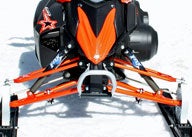
Cutting-edge shock technology
For 2010, Yamaha is rolling out a leaner and more refined line up of sleds. Under close examination, you will find that Yamaha is offering cutting-edge shock technology and clearly segmented chassis and suspensions for groomed trail and big bump terrain riding.
In the Yamaha’s trail segment, you have four distinct model platforms, the Nytro, Phazer, Vector, and Apex. The Nytro and Phazer are targeted for aggressive terrain riding while the Apex and Vector are aimed at the groomed trail market. While Yamaha has made several updates and advances to its mountain sleds, we’ll focus exclusively on trail sleds.
Dual Shock Pro
The Nytro and Phazer models are built on rider-forward chassis with big-bump oriented Dual Shock Pro rear suspension while the Apex and Vector have a traditional chassis layout with Mono Shock rear skid.
FX Nytro RTX SE is Yamaha’s flagship terrain sled and showcases the company’s latest suspension and chassis technology. The front suspension carries the FXG2 geometry, which delivers responsive steering without feeling high-strung, thanks to a 26-degree caster angle at the front spindle. Like all current competition in the class, the front suspension is equipped with dual A-arms and extruded aluminum spindles. But RTX SE is exclusively equipped with one of the most advanced stock shocks — the Fox FLOAT X remote reservoir air shocks. These shocks are very similar to the top-of-the-line Fox FLOAT Evol snocross racing shocks. In comparison, the Evol has a different air chamber and an external high-speed compression damping adjuster, otherwise FLOAT X is pretty close.
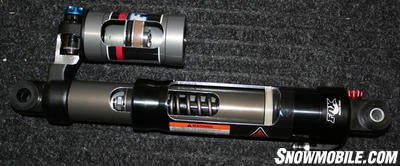 The Fox FLOAT X, fitted exclusively to the Nytro RTX SE, provides an incredible range of damping adjustment and is very similar to Fox FLOAT X Evol snocross shocks.
The Fox FLOAT X, fitted exclusively to the Nytro RTX SE, provides an incredible range of damping adjustment and is very similar to Fox FLOAT X Evol snocross shocks.The stout FLOAT X features a 46mm body, huge 16mm shafts, dual-stage air spring, and high-capacity remote reservoir to handle the most extreme riding conditions. In addition, the FLOAT X damper offers 12 effective clicks of low-speed compression and 20 clicks of low-speed rebound with 4 full turns in ½ turn increments for high-speed rebound. This gives the rider an incredible amount of external adjustability before it is necessary to break down the shocks and adjust the shim stacks for a particular application.
The shocks feature a high-rate negative spring that allows the shock to run high air pressures in the main chamber for excellent roll control without compromising ride height. Of course, these shocks are lighter and resist contamination better than a majority of high pressure coil spring gas shocks because the FLOAT Xs have a very efficient wiper blade that helps prevent snow from being drawn into the shock bodies.
Latest Technology
The Dual Shock Pro 46 rear suspension incorporates Yamaha’s latest technology and uses premium shocks to effectively soak up the bumps. The slide rails are reinforced in the middle to take the pounding encountered during ditch banging. In addition, the rear to front arm coupling is improved for better overall handling. On the rear arm, a 46mm triple clicker high-pressure gas shock delivers 12 clicks of high- and low-speed compression, and rebound is fully adjustable to smooth out the most brutal terrain. On the front arm, a 40mm high-pressure gas shock with a 16mm shock shaft provides 16-clicks of compression and rebound damping adjustment.
 The cutaway Fox FLOAT shows the large air chamber and internal floating piston.
The cutaway Fox FLOAT shows the large air chamber and internal floating piston.The Nytro is also available in two other trim levels, the FX Nytro RTX and FX Nytro. These sleds carry the same chassis and suspension package, but are equipped with different shocks. The RTX carries Fox FLOAT air shocks on the FXG2 front suspension. A single air pressure adjustment sets the damping rate for the FLOAT. These shocks provide a soft initial rate and a more progressive rate throughout the range of travel. Out back, the rear skid uses a pair of 40mm high-pressure gas shocks with rebound and compression damping adjustment. The base-level FX Nytro carries the GYTR coil-spring 40mm high- pressure gas shocks on the double A-arm front suspension. These dampers have a dual clicker rebound and compression damping adjustment. And the Dual Shock CK rear suspension comes with 40mm high-pressure gas shock using 14mm shock shafts. On the crossover side, the Nytro XTX, a sales smash hit last season, returns for its second year of service. Up front, you will find the 40mm GYTR dual clicker high-pressure gas shocks, and of course, in back you will find the 144-inch rear skid with tipped up rails with a 40mm high-pressure gas shock and 12-1/2 mm shock rods.
Phazer Updates
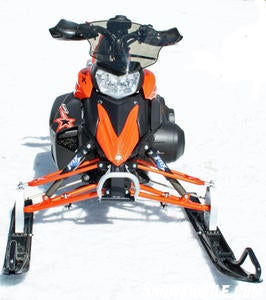 The Phazer RTX is equipped with the lightweight FOX FLOAT air shocks.
The Phazer RTX is equipped with the lightweight FOX FLOAT air shocks.The Phazer returns in 2010 and comes in two iterations – RTX and GT – while the base Phazer has been dropped. The Phazer RTX and GT are built on the FX Chassis, which features lightweight, rigid diecast subframe member and chromoly tube construction. Like the Nytro, the Phazer chassis places the rider forward into a more aggressive riding position. Both Phazers use the same double A-arm front suspension with extruded aluminum spindles and the Dual Shock rear suspension. The Phazer RTX, like last year, is equipped with Fox FLOAT shocks. A single air rate adjustment sets the damping range for these rebuildable and revavleable air shocks, but unlike the FLOAT X there are no external valving adjustments. Out back, the RTX’s narrow coupled skid features oversized carrier wheels on the rear upper cross shaft to decrease rolling resistance. The cantilever system on the rear arm keeps track tension more consistent throughout the range of travel. The front lower shock mount is on a cam to increase the shock rate through its travel. A couple of 36mm KYB (Kayaba) high-pressure gas shocks with compression damping adjustment regulate the suspension.
The Phazer GT falls under the Groomed Trail category and as such its shock and spring package is calibrated for stutters and mid-sized bumps found in most trail riding conditions. The GT’s dual A-arm suspension carries high-pressure 40mm GYTR shocks with compression and rebound clickers. The dual shock CK suspension is equipped with a 40mm compression and rebound damping clicker on the front arm while the rear arm is regulated by a 36mm KYB shock.
Groomed Trail
Yamaha returns with the Apex and Vector models for the groomed trail riders. Both sleds utilize the Deltabox II chassis, the second-generation double A-arm front suspension geometry, and trail-oriented Mono Shock rear suspension system. While the Apex is equipped with Mono Shock RA rear skid, the Vectors receive the Mono Shock II RA rear suspension. This suspension received 13 changes, including a lower front arm, track tension adjuster, stronger rails, new needle bearings, and larger rear axle.
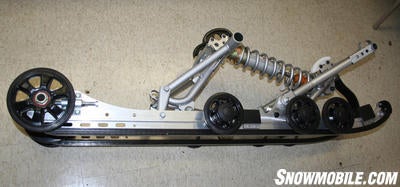 The Mono Shock RA II rear suspension features tunnel-mounted dial adjuster for damping control.
The Mono Shock RA II rear suspension features tunnel-mounted dial adjuster for damping control.Last year, Yamaha offered the Apex in four trim levels, the Apex (similar to last year’s ER), GT, LTX, and LTX GT. The front suspension uses long A-arms, and short spindles with a 23-degree caster angle for flat cornering and stable handling.
The Apex GT and LTX GT are equipped with the Ohlins Mono Shock II EC rear suspension. While the Dual Shock suspensions use torsion springs, the Mono Shock uses a massive coil spring to share the damping duties between front and rear arms. In addition, both arms are fully coupled to communicate terrain forces from front to rear as well as rear to front. This rear skid offers on-the-fly compression damping adjustment of the rear shock. By pushing a handlebar-mounted switch in suspension mode, the rider can adjust the shock valving from full soft to full stiff. In addition, rebound can be adjusted on a shock-mounted clicker. Up front, the Apex GT is equipped with GYTR high-pressure gas shocks with remote reservoirs that have 12 clicks of compression and 20 clicks of rebound damping.
Different Shocks
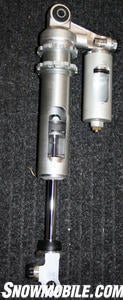 The GYTR coil-over gas shocks have both compression and rebound damping clickers.
The GYTR coil-over gas shocks have both compression and rebound damping clickers.The Apex and Apex LTX carry the same chassis and suspension, but with a different shock package. On the Apex, the double A-arm front suspension features 40mm high pressure gas shocks with no external damping adjustment and the rear skid has a 46mm KYB that has the remote adjuster located on the tunnel. This tunnel mounted dial adjuster allows the rider to quickly and clearly set the damping level to match rider weight, preference and the prevailing riding conditions.
On the RS Vector models, you will find the double A-arm front suspension equipped with 40mm GYTR dual clicker high-pressure gas shocks. In an approach similar to the Apex and Apex LTX, the RS Vector GT and RS Vector LTX GT are equipped with the same shocks. But these models have a little different setup from last year. Up front, the shock valving has been increased, and the sway bar is a bit thicker at 11mm to provide less roll and better suspension performance. As mentioned, the Vector models carry the evolved and improved Mono Shock II RA Rear suspension. The skid also has a new reverse track tensioner that faces forward for direct access to the adjuster bolt, which is unlike the older adjuster that was accessed through the track window. The rear skid has a 46mm high-pressure gas shocks and tunnel mounted dial adjuster that gives a full range of compression damping adjustability.
Related Reading 2010 Ski-Doo TNT 550 vs Yamaha Phazer RTX 2010 Yamaha Vector GT FI Review 2010 Yamaha Lineup Preview








 Your Privacy Choices
Your Privacy Choices